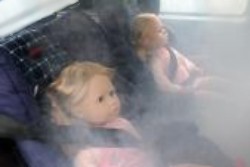 The BMA are at it again. By leveraging (Dr No has been reading too many financial reports of late) proper indignation at unspeakable parents who use their cars as smoke-houses to kipper their kids, they now propose a ban on all smoking in any car – even when the smoker is the only occupant. Perhaps they even want to ban smoking in cars when there is no one in the car. Bloggers and commenters too numerous to mention have pointed out the libertarian and practical legal objections to a total ban – but what about the science behind their proposal? Their briefing paper carries the mark of the BMA Board of Science on its front cover – so the science had better be good. But is it?
The BMA are at it again. By leveraging (Dr No has been reading too many financial reports of late) proper indignation at unspeakable parents who use their cars as smoke-houses to kipper their kids, they now propose a ban on all smoking in any car – even when the smoker is the only occupant. Perhaps they even want to ban smoking in cars when there is no one in the car. Bloggers and commenters too numerous to mention have pointed out the libertarian and practical legal objections to a total ban – but what about the science behind their proposal? Their briefing paper carries the mark of the BMA Board of Science on its front cover – so the science had better be good. But is it?
The bold headline figure in much of today’s coverage of the ban was that smoking in cars exposed those inside to a staggering twenty three times more toxins than the levels found in a smoky bar. The BMA press release noted coolly:
“Research compiled by the BMA shows that there is strong evidence that smoking in vehicles exposes non-smokers to very high levels of second-hand smoke. This is because of the restrictive internal environment in motor vehicles which exposes drivers and passengers to 23 times more toxins than a smoky bar”
while the briefing paper itself said:
“…studies demonstrate that the concentration of toxins in a smoke-filled vehicle is 23 times greater than that of a smoky bar, even under realistic ventilation conditions”
and tacked on three references. Realistic ventilation, it added in a footnote, “is described as driving at average roads speeds with all four windows completely open” – which sounds more than a little hazardous in itself. But then, that is the BMA for you.
Now, a figure of ‘23 times’ suggests a degree of scientific precision, so Dr No decided to check the references where he could. As it happens, all three are available: here, here and here.
All too soon (this was quickly becoming a familiar story), the evidence started to thin and then disappear like smoke rings blown in a breeze. Strands of the all too common incestuous Chinese whispers started to appear, as one source quoted another in a merry-go-round of mutual support. And then came the crucial evidence for ‘twenty three times more toxins than a smoky bar’ – but it went up in smoke – in an Irish pub (ref 1, page 14):
“To provide some context about the PM 2.5 levels recorded in this study, in a recent report of PM 2.5 levels in Irish pubs throughout the world, the average level of PM 2.5 in 48 Irish pubs that allowed smoking was 340 μg/m3. In Condition 1 (motionless car with all windows closed), the average level during cigarette smoking (M = 3,850.9 μg/m3, range = 1,696.8 to 7654.7 μg/m3) was over 11 times the level of an Irish pub in which smoking was allowed.”
A motionless car with all windows closed…but still nowhere near twenty-three times the ‘smoky bar’…just eleven times…
And then Dr No came across this. Produced by a couple of anti-smoking campaigners from Australia only last year (and so more recent than the three references the BMA rely on for the ‘twenty-three times’ figure), it thoroughly debunks the ‘twenty-three times’ myth. No need for Dr No to rehearse the argument – it had already been done – by anti-smoking people.
Unsurprisingly, the BMA briefing paper makes no mention of this inconvenient paper. Perhaps the BMA knew of it, but suppressed it. Or perhaps they never even came across it, which is a pity, because it contains a pithy and pertinent observation:
“The biggest danger of inaccurately interpreting research on smoking in cars for the sake of a snappy media sound bite is to lose favour with an overwhelmingly supportive public and to provide ammunition for opponents of tobacco control.”
Board of Science? More Board of Myth. Dr No is left gasping…
